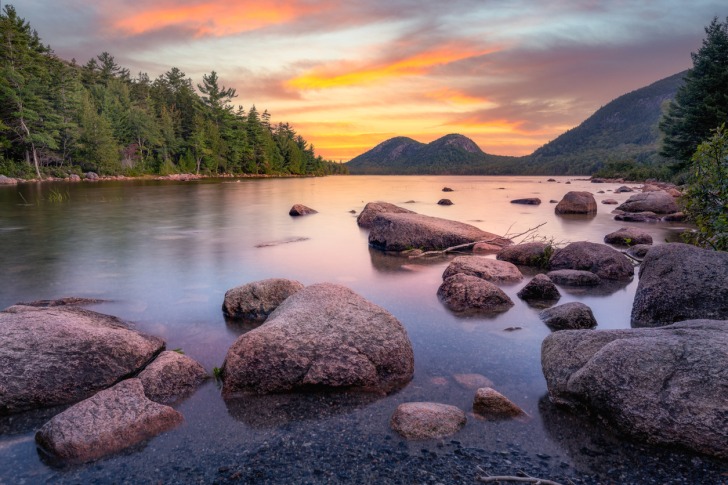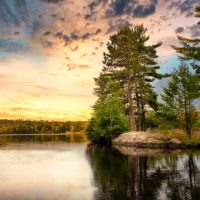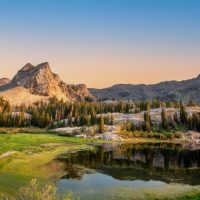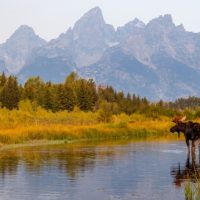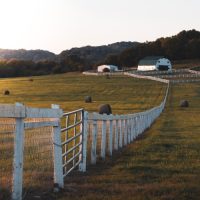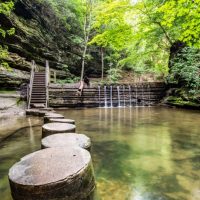Maine is well known for its forests.
In the fall, many people travel to Maine to see the changing leaves.
89% of Maine is forested.
This unspoiled habitat raises the question, are there snakes in Maine?
Contents
So… Are There Snakes in Maine?
Yes, there are snakes in Maine.
The state has 9 species that call Maine home.
None of these species are venomous.
This means you can relax if you stumble on a serpent in Maine.
However, snakes should still be respected.
Holding or attempting to catch a snake can result in a nasty bite.
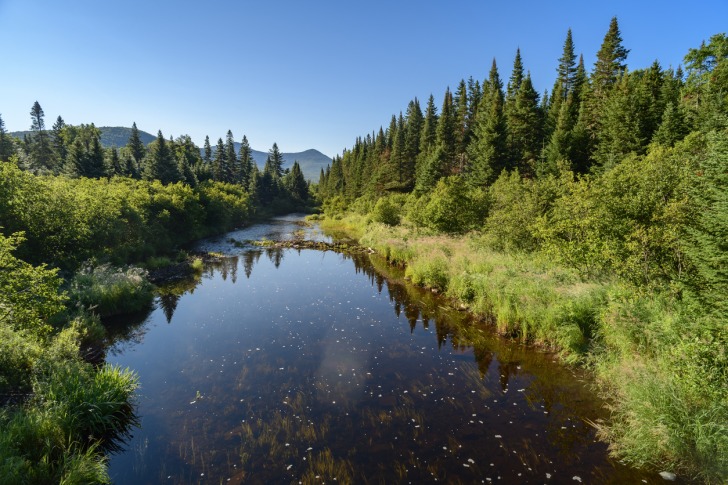
Snake Species in Maine
Understanding the nine species of snakes in Maine can help you enjoy your time outdoors.
Garter Snakes
Garter snakes are the most common snake in the U.S.
These snakes are thin and have three stripes that run down the length of their back.
They are not harmful to humans, but they do have a mildly toxic venom.
These snakes can be found nearly anywhere, including residential areas and forests.
The garter snake and ribbon snake are both types of garter snake.
Northern Water Snake
Northern water snakes are thought to be the most common water snakes in the U.S.
They are brown, gray, or tan, and have dark brown bands that go down their body.
They are often mistaken for the deadly cottonmouth or copperhead.
Northern water snakes are nonvenomous, but they do pose a risk to humans.
They can deliver a bite that causes injury, even though they don’t deliver venom.
In addition to the injury of the bite itself, there’s a risk of infection.
They will typically only bite if they are handled or stepped on, and will often flatten their bodies in warning first.
Black Racer
The black racer is black, with a light underbelly.
Unfortunately, it’s endangered in Maine.
It reaches 5 feet long and is known as Maine’s largest snake.
They can also move at speeds of 10 mph, which is very impressive for an animal without legs.
Red Bellied Snake
Red-bellied snakes are one of the most beautiful serpents in Maine.
They are small, usually about 1 foot long.
They are usually brown, reddish brown, or gray.
They have two rows of darker brown stripes on the back.
They will also have three spots behind their head.
In young snakes, this is a solid band.
The underside of their body is red or orange, as the name suggests.
Rarely, this can be yellow or black.
You’ll find them throughout Maine, although they are rare in the Northern tip of Maine.
They live in forests, fields, gardens, and rocky areas.
They typically make their home under objects, including logs, rocks, and piles of debris.
Smooth Green Snake
This common snake is small, usually 1 to 2 feet long, and slim like the garter snake.
They have a beautiful green color, with a white or yellow belly.
Young green snakes are usually a darker olive green or blue-gray.
They are located in the southern, central, and eastern regions of the state.
These snakes can be found in both natural and residential areas.
They make their home in meadows, forests, and grasslands. You’ll also spot them in yards and gardens.
Milk Snake
Milk snakes are found in most of Maine, but they aren’t found in the northern part of the state.
They are usually 2 to 3 feet in length but can reach 4 feet long.
Their body is brown or gray, with red or brown patches on their back.
Their belly is black and white, with a checkerboard pattern.
Milk snakes can be mistaken for a rattlesnake.
They will wiggle their tail, which can produce a rattling sound if there are leaves or sticks in the area.
This is an evolutionary trick.
Animals, and humans, know to beware of the rattler’s sound, so they leave the milk snake alone.
Brown Snake
Brown snakes are brown, and they have two rows of black dots on their back.
They can be found in residential areas and natural habitats.
They live in southern and central Maine.
They are rare and unfortunately endangered in the state.
Ring Necked Snake
Ring-necked snakes are small, with most reaching about a foot long.
They have a distinctive ring around their neck that is yellow or red.
Their body is typically brown or gray.
Their bellies can be yellow, red, or brown, and sometimes have a striped pattern.
These snakes are nocturnal and shy, so spotting them is rare.
Is it Safe to Go on a Trek in Maine?
Yes, it’s safe to explore Maine.
You don’t have to worry about snakes, because the state doesn’t have any venomous serpents.
However, there are some dangers you should be aware of.
Natural Hazards
What Maine lacks in snake danger, it makes up for in natural hazards.
Blizzards and freezing temperatures are a yearly hazard.
Maine can also have tornadoes, hurricanes, severe storms, flooding, landslides, and drought.
Maine Wildlife Dangers
Many people believe bears are the most dangerous animal in Maine.
They can attack, usually, if they feel their babies are threatened.
However, moose are responsible for many more animal attacks each year.
Other dangerous animals include ticks, snapping turtles, and great white sharks.
Interesting Snake Facts in Maine
Maine once had a poisonous inhabitant, the timber rattler.
This rattlesnake is deadly, with four times the death rate of copperheads.
It’s easy to see why Maine natives wanted the snakes gone from their land.
At some point, probably in the 1800s, they succeeded.
Timber rattlers are extinct in Maine, and endangered in many other areas.
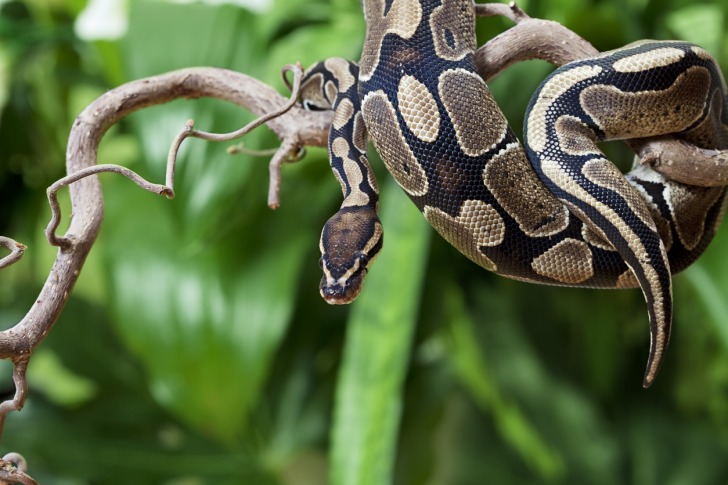
3 Safety Tips for Exploring Nature in Maine
1. Enjoy Wildlife From a Distance
It can be exciting to see wildlife in its natural habitat.
However, you should never approach a wild animal.
Don’t feed them or try to get closer to them.
If you happen to find yourself too close to an animal, back away slowly.
2. Be prepared for the Weather
In the winter, temperatures can average a frigid 15-25 degrees.
Snow storms and blizzards are a fact of life.
In the summer, temperatures are mild, usually around 70 degrees.
However, summer storms can bring rough weather.
If you go on a trek in Maine, be sure that you are dressed for the weather.
Bring snow or rain gear along, depending on the season, so you aren’t caught unaware.
3. Travel With Others
When you are exploring the Maine wilderness, it’s best to have a partner.
If you do choose to go alone, someone should know exactly where you are going, and when you will be back.
If you don’t return, they can alert the local authorities.
Summary
Maine has nine species of snake, but all are harmless.
As long as you don’t attempt to handle the snake, it will not pose a problem.
You can enjoy Maine’s natural beauty worry-free.
Maine Safety Overview
READ THE FULL REPORT: Maine Safety Review
Safety Index:
- OVERALL RISK: LOW
- TRANSPORT & TAXIS RISK: LOW
- PICKPOCKETS RISK: LOW
- NATURAL DISASTERS RISK: MEDIUM
- MUGGING RISK: LOW
- TERRORISM RISK: LOW
- SCAMS RISK: MEDIUM
- WOMEN TRAVELERS RISK: LOW
Frequently Asked Questions
What is the most common snake in Maine?
The common garter snake is the most common serpent found in the state.
What should I do if I find a snake in my yard?
If you spot a snake in your yard or the woods, it’s best to leave it alone.
Snakes will eat rodents and insects around your home, so they are good to have.
Since there are no venomous snakes in Maine, you don’t have to worry about your safety.
What should I avoid with snakes in Maine?
Avoid picking up snakes you find.
Although Maine has no venomous snakes, several species will bite if provoked.
